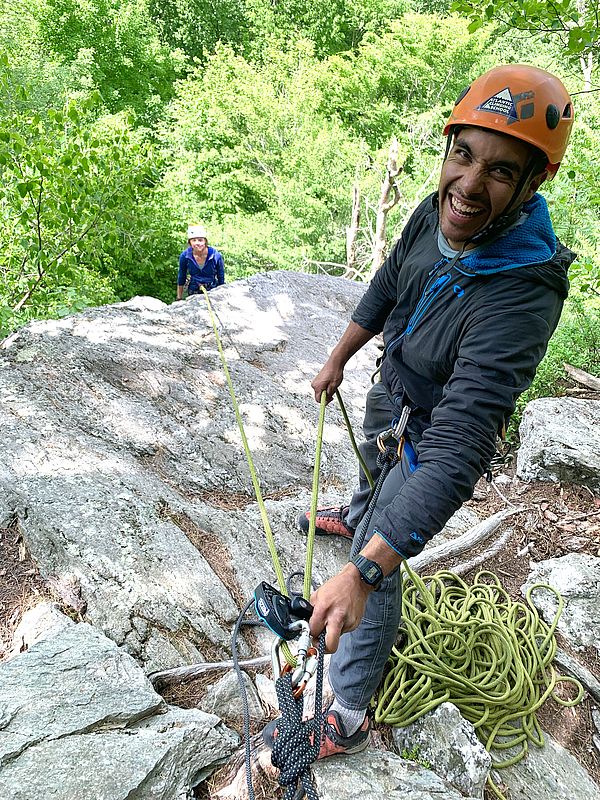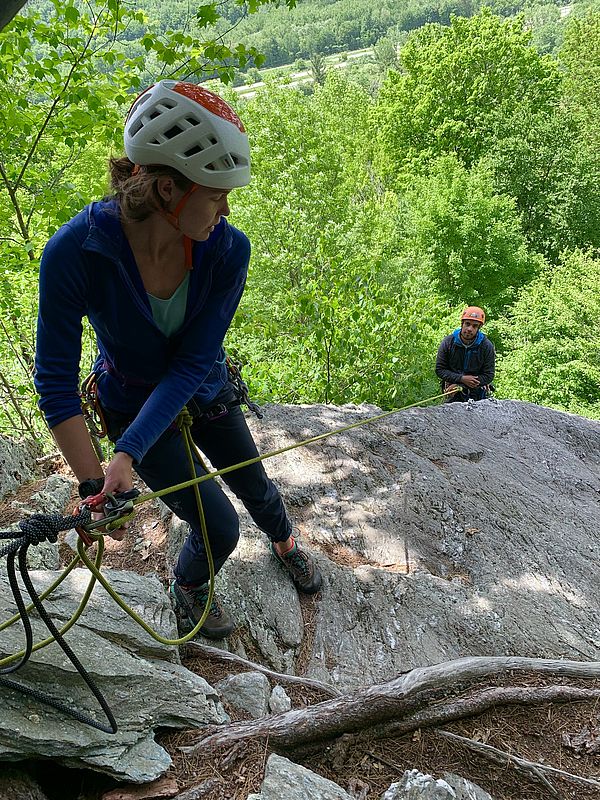Mindset for Becoming a Successful Single Pitch Instructor
In this blog post, I'm looking at the American Mountain Guides Association's (AMGA) Single Pitch Instructor (SPI) Course & Exam/Assessment. Specifically, I'm looking at trad rock climbing prerequisites for both the Course and the Exam/Assessment (which I'll refer to as the “Assessment” from here on out). In here, you'll find some helpful ways to approach the prerequisites that will be helpful in moving towards your SPI goals. And while this post is targeted towards the AMGA SPI, there is also a lot of very beneficial information here for anyone looking to get into and grow their trad rock climbing leadership skills.
The prerequisites for participation in the AMGA SPI are that you have a minimum of 15 trad rock climbs of any grade for the Course and 40 climbs 5.6 or higher, and on a variety of rock types, for the SPI Assessment. So let's look at those numbers. Fifteen and forty are good places to start, but ultimately, realize that it's just the starting point and it's just a number. And, in fact, in some respects, these prerequisites are odd, for several reasons. Let's take a look at some of the “Why?”
Get Your Whip Out & Don't Cancel for Rain
Having led fifteen or forty trad rock climbs really doesn't tell anyone anything about how well a person can place gear—because the truth of it is that most of these people never take a fall during those leads. So, all that it really says is that the person has never fallen on a 5.6 climb. Of course, prerequisites are necessary, and you can probably understand why the prerequisite is framed this way, but, in all reality, what I'd really like to know about the participants is, “How many whips have you taken on lead?” This is a much bigger indicator about one's ability to skillfully lead trad rock.
So get your whip out! Time to log some frequent flyer miles. But be wise about when. Don't go taking whips on a single piece of gear ten feet above your last one: Sew it up, even double up pieces into a micro-anchor at cruxes, and pick the right kind of climb to do it on—steeper is better, and ledge-free. The next thing you've got to do is not cancel your climbing days due to rain. Just shift the focus—find some generously protected routes and get out for a day of aid climbing. If you're feeling queezy and uneasy about really putting your placements to the test during a lead fall, there's nothing like putting full body weight and a bit of wiggle into each piece while aid climbing to boost that confidence.
Getting the Rope Up the Best Routes, Regardless of the Participants or Conditions
The second reason why the prerequisites should be thought of as just a number and just a starting point has to do with the “5.6 or higher” piece of the equation. In this day and age, when climbing gyms are as ubiquitous as Starbucks, a good deal of aspiring outdoor climbers are going to be able to tackle far more than 5.6 on their first day out. On a recent SPI Assessment we had a couple of young gym crushers who needed ropes on some 5.11s in order to stay challenged and engaged (the second day of the Assessment involves taking a real group of participants out) . Of course, you can sometimes climb a 5.6 to put a rope on a 5.11 climb, but if 5.6 is your max, those opportunities are often going to be as hard to find as a jug on a 5.15. The higher a grade you can climb, the more likely you will be able to hang lines on even harder routes.
Extending that a bit further, consider that, as a climbing leader, you've often got to get the ropes up at the start of the day. If you live anywhere outside of the Southwest, it's not uncommon that the rock starts the day damp. And if you live in the East, the whole day may stay pretty damp during the peak of summertime humidity. And if you live just about anywhere, at some point in the year you're going to be starting the day with chilly fingers. If 5.6 is your best lead on a good day, it's going to be hard to get many a damp, cold climbing day going in a timely manner.
Long After the Assessment, Time is the Real Test
On the note of “timely manner”, it's also worth considering what a rock leadership day looks like. Most guide companies staff single pitch rock climbing days with a ratio of six participants for each instructor. If you've got six participants with a variety of skill levels, that means you may need to get at up to three climbs going to span that spectrum and challenge everyone. Ideally, of course, you'd have the ability to climb a single climb that allows you to tag up 1-2 ropes for establishing neighboring climbs. But if you have to actually climb 2-3 separate climbs, and it takes you 20 minutes to lead a pitch, that's 40 minutes to an hour, best case scenario. You really want to be aiming to get your lower-level leading down to 10-15 minutes for a full 30m climb. So, when you're out training, climb and protect your climbs safely first and foremost, but take a look at the clock and start working to trim that time down.
Other Realities of Rock Leadership
Above, I alluded to the fact that you may be leading while also tagging up 1-2 other ropes. Translation: Rope drag potential. Add to it the fact that you're often taking a belay from a person new to belaying a leader. Yes, you'll definitely train that belayer well before you trust your safety to them, but the potential for some unpleasant pulling of your chain is real. That's not the end of it—let's go back to the fact that you might be taking your lead belay from a new lead belayer. You can imagine that might just boost your nerves and dampen your palms a bit. Add to that a few more nerves from having all the participants watching and the fact that you're under time constraints AND potentially climbing on a damp morning or humid afternoon, and you'll be burning through a chalk block every pitch!
One last bit to consider is expanding your climbing range. Slab, cracks, corners, granite, sandstone, gneiss, every climber has styles of climbs and types of rock they prefer and excel at. An effective rock instructor has got to be able to get climbs up in a variety of terrain. Being a solid 5.6 face climber but struggling up 5.4 crack is just not going work. In the AMGA Ski Guide Certification program, because skiing movement skills are harder to quantify than rock grades, the prerequisites once included the requirement that you could “ski in a way that inspires your clients.” That requirement always made me chuckle—I imagined starting each descent with some kind of inspirational speech or something. But the need for guide-instructors to inspire our clients is real, whether skiing or climbing. Remember the “I” in “SPI”--Instructor: At the most basic level, your climbers should be inspired by your movement skills, using it as a method for quietly learning, and seeing it as a goal to work towards. Beyond that, you also need acumen in a range of styles and types of climbing so that you effectively coach them in their own movement progression.
Climb High, Aim High
So aim high—meet the prerequisite for training and certifying as an AMGA Single Pitch Instructor for sure. Then, take those SPI wings and start flying! Push the grades, take some well-strategized whips, get yourself out of your climbing neighborhood and preferred climbing styles. I encourage you to think about the SPI prerequisites, take them seriously all along the way--and then exceed them as quickly as you can. Most of all, have fun during the learning journey—after all, it's a journey that never ends.


